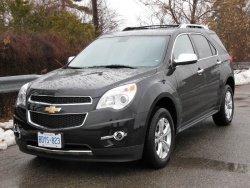 2010 Chevrolet Equinox LTZ FWD. Click image to enlarge |
|
Related articles on Autos
Manufacturer’s web site
|
Review and photos by Jil McIntosh
Find this vehicle in Autos’s Classified Ads
Photo Gallery:
2010 Chevrolet Equinox
Oshawa, Ontario – One thing about General Motors: although it has its woes, and it’s still not entirely out of the woods following its bankruptcy and the overall state of the auto industry, it can turn out some decent products when it puts its mind to it. In the compact SUV segment – a still-lively category with buyers, and an important one for an automaker to have something worthwhile – it offers the new-for-2010 Chevrolet Equinox, a vehicle that can finally go head-to-head with just about everything else that’s out there.
The new Equinox also appears at GMC as the Terrain, and both are built at GM’s plant in Ingersoll, Ontario. Due to the discontinuation of the brands, the Pontiac Torrent and Saturn Vue that were built off the last-generation Equinox are no longer available.
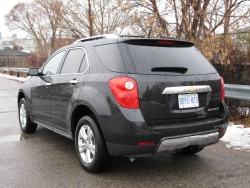 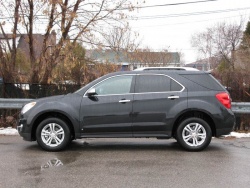 2010 Chevrolet Equinox LTZ FWD. Click image to enlarge |
Two engines are available: a 2.4-litre Ecotec four-cylinder is the default across all trim lines (LS, two LT levels, and LTZ), while the LT and LTZ lines can be optioned to a 3.0-litre V6. Both engines use a six-speed automatic, and both can be optioned to all-wheel drive that runs primarily in front-wheel but sends power to the rear when needed. My tester was the 2.4-litre, in front-wheel drive, and in LTZ trim. I like that GM makes the smaller engine available in all trim lines; too often, if you want all of the luxury features, they only come with the bigger engine, or only with all-wheel drive.
Prices for the 2.4-litre in front-wheel drive range from $25,995 to $33,460, while all-wheel drive models are $27,605 to $35,070. Adding the V6 engine to any of them is another $2,050, which includes $1,725 for the engine and another $325 for the mandatory 18-inch wheels that go with it (17-inch painted aluminum rims are the default).
I seldom turn down more horsepower, but in the Equinox, I actually prefer the four-cylinder to the V6. It certainly isn’t as strong – 182 horsepower to the V6’s 264 ponies – but it feels livelier on acceleration, and has more than enough grunt in everyday driving. A four-cylinder that’s better than the V6? As odd as it sounds, believe it: this is one exceptionally well-done powerplant. For most owners, the only reason to move up would be for towing, since the V6 handles 3,500 lbs. (1,588 kg) to the 1,500 lbs (680 kg) that the four-cylinder can pull. On paper, the front-wheel four-cylinder rates 9.2 L/100 km (31 mpg) in the city, and 6.1 L/100 km (46 mpg) on the highway; in very cold weather, I got a real-world average of 12.4 L/100 km (23 mpg).
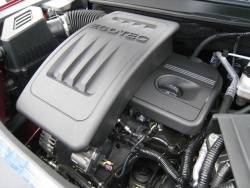 2010 Chevrolet Equinox LTZ FWD. Click image to enlarge |
The Equinox also includes an “Eco” button which, when activated, sets many things in motion in order to conserve as much fuel as possible. It resets the transmission shift points, applies the torque converter clutch sooner and leaves it on longer, makes the throttle less sensitive, lowers the idle speed, and is more aggressive about shutting off fuel on deceleration. All of that conspires to make the four-cylinder noisier as it goes about its business, so GM throws in a pretty slick piece of technology called Active Noise Cancellation. It’s similar to the way noise-cancelling headphones work, sending out a sound wave through the stereo speakers and subwoofer to counteract the engine noise, which it detects through two microphones in the headliner. The system is only on the four-cylinder – the V6 is inherently quiet enough – and when combined with other sound-deadening tricks such as laminated glass and extra absorbent material in the dash, it makes the Equinox a much more quiet ride than expected for the segment and the price.
The Equinox is a nice driver: the four-cylinder uses electric power steering to the V6 model’s hydraulic unit, but it’s well-tuned for a more organic feel. The six-speed also shifts smoothly and keeps the engine in its sweet spot, but its manual shift mode is operated by a button on the side of the shift lever, which can be awkward to use. Naturally there are limits to how hard you can take a corner, but body lean is minimal, and it feels tight and well-controlled, and only the very nastiest potholes make their way through the suspension and up into the passenger compartment. The brakes require more effort than expected, though, and the pedal feels dull and lifeless.
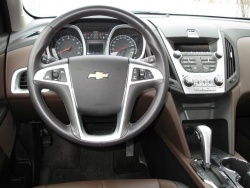 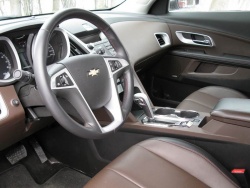 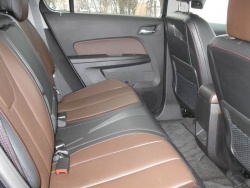 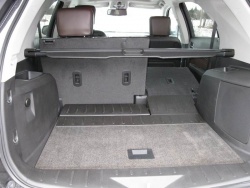 2010 Chevrolet Equinox LTZ FWD. Click image to enlarge |
The seating position has the high hip point expected of an SUV, and seeing out the front is fine, but the thick rear C-pillar cuts down on visibility when making shoulder checks.
The LTZ buffs up the interior with two-tone perforated leather seats. Having also driven a lower trim line, I thought the cloth seats were a bit softer and more comfortable, although that could also have been my prejudice against leather seats, which I always find are too hot, too cold or too slippery in comparison to fabric. In any case, the Equinox benefits from GM’s newfound interest in cabin quality, with panels that fit together accurately and a handsome, cohesive design. There’s still a lot of smooth, hard plastic, but you’ll pretty much have to move up to a premium brand to top the Equinox.
There’s plenty of room for small objects, although the door’s map pocket isn’t actually big enough to hold a map; on the other hand, you can tuck a laptop into the cavern hidden below the armrest in the centre console. GM is starting to get into fiddly-button territory, and I’d like to see the centre stack made easier to operate when you’re driving, since the small black icons on the silver slab-style buttons can be hard to pick out at a quick glance. All but the base LS model have automatic climate control, so you can set-it-and-forget-it, but it still should be viable to switch modes safely at speed.
There are only two rows of seats; you need to move up to the Chevrolet Traverse to get three rows. The second row, called a Multi-Flex seat, can be slid up to 203 mm (8 inches) back or forward, depending on whether you want more legroom or cargo space. The seats fold, although not entirely flat, giving a floor length of between 80 cm with them up, and 160 cm with them down. A power liftgate is standard on the LTZ, and it can be programmed to open to one of two heights, which helps to better accommodate shorter operators or lower garage ceilings.
All Equinox models come with the usual palette of features: a/c, stability and traction control, keyless entry, power windows, cruise control, CD player with auxiliary input, and power mirrors. Moving up the trim lines, the LT1 model adds heated mirrors, roof rails, automatic climate control and a vehicle information centre, while the LT2 (who thinks up these exotic names?) includes remote starter, a backup camera that displays in the rearview mirror, tire pressure monitoring system, power driver’s seat, Bluetooth, XM satellite radio and a USB port. My LTZ tester stepped that up with the power liftgate, projector-style halogen headlights, chrome exterior accents, rear parking assist, and the leather seats with memory.
Overall, between its quiet composure, its smooth ride and its interior, you could easily put a Buick badge on this and no one would be the wiser. Cleanly styled, intelligently priced and nice to drive, the Equinox takes GM to a new level. If it can sustain this momentum, it’s got a serious chance at regaining the market share it’s lost to its Asian competitors over the years.
|
Pricing: 2010 Chevrolet Equinox LTZ FWD
Click here for options, dealer invoice prices and factory incentives
Specifications
Competitors
Crash test results
|







 Follow Autos on Twitter
Follow Autos on Twitter



